2021年考研英语将出新题型排序题
2021年考研英语(一)新题型概述
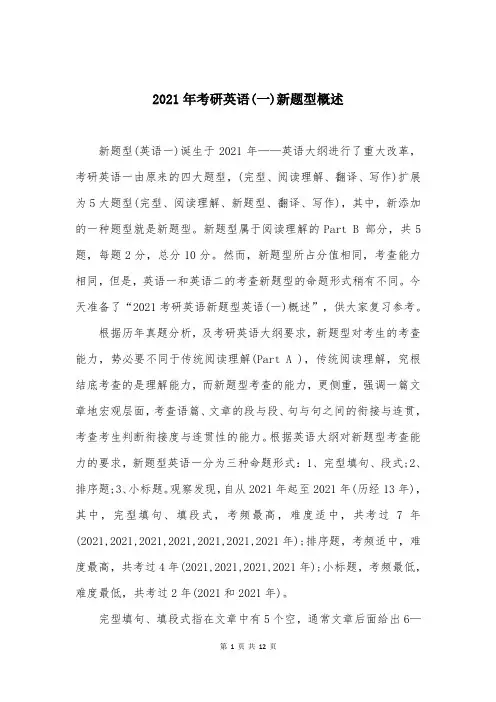
2021年考研英语(一)新题型概述新题型(英语一)诞生于2021年——英语大纲进行了重大改革,考研英语一由原来的四大题型,(完型、阅读理解、翻译、写作)扩展为5大题型(完型、阅读理解、新题型、翻译、写作),其中,新添加的一种题型就是新题型。
新题型属于阅读理解的Part B 部分,共5题,每题2分,总分10分。
然而,新题型所占分值相同,考查能力相同,但是,英语一和英语二的考查新题型的命题形式稍有不同。
今天准备了“2021考研英语新题型英语(一)概述”,供大家复习参考。
根据历年真题分析,及考研英语大纲要求,新题型对考生的考查能力,势必要不同于传统阅读理解(Part A ),传统阅读理解,究根结底考查的是理解能力,而新题型考查的能力,更侧重,强调一篇文章地宏观层面,考查语篇、文章的段与段、句与句之间的衔接与连贯,考查考生判断衔接度与连贯性的能力。
根据英语大纲对新题型考查能力的要求,新题型英语一分为三种命题形式:1、完型填句、段式;2、排序题;3、小标题。
观察发现,自从2021年起至2021年(历经13年),其中,完型填句、填段式,考频最高,难度适中,共考过7年(2021,2021,2021,2021,2021,2021,2021年);排序题,考频适中,难度最高,共考过4年(2021,2021,2021,2021年);小标题,考频最低,难度最低,共考过2年(2021和2021年)。
完型填句、填段式指在文章中有5个空,通常文章后面给出6—7个未知选项(句子或是段落),考生根据衔接度最高,连贯性最大为原则,选出与已知信息相似性最大的选项,选填到文章中。
简而言之,与传统完型填空的区别是,新题型选填的是句子或者段落。
以2021年的完型填句、填段式为例Part BDirections:In the following text, some sentences have been removed. For Questions 41-45, choose the most suitable one from the fist A-G to fit each of the numbered blanks. Mark your answers on ANSWER SHEET. (10 points)How does your reading proceed? Clearly you try to comprehend, in the sense of identifying meanings for individual words and working out relationships between them, drawing on your explicit knowledge of English grammar (41) ______you begin to infer a context for the text, for instance, by making decisions about what kind of speech event is involved: who is making the utterance, to whom, when and where.The ways of reading indicated here are without doubt kinds of of comprehension. But they show comprehension to consist not just passive assimilation but of active engagement inference and problem-solving. You infer information you feel the writer has invited you to grasp by presenting you with specificevidence and cues (42) _______Conceived in this way, comprehension will not follow exactly the same track for each reader. What is in question is not the retrieval of an absolute, fixed or “true” meaning that can be read off and clocked for accuracy, or some timeless relation of the text to the world. (43) _______Such background material inevitably reflects who we are, (44) _______This doesn’t, however, make interpretation merely relative or even pointless. Precisely because readers from different historical periods, places and social experiences produce different but overlapping readings of the same words on the page-including for texts that engage with fundamental human concerns-debates about texts can play an important role in social discussion of beliefs and values.How we read a given text also depends to some extent on our particular interest in reading it. (45)_______such dimensions of read suggest-as others introduced later in the book will also do-that we bring an implicit (often unacknowledged) agenda to any act of reading. It doesn’t then necessarily follow that one kind of reading is fuller, more advanced or more worthwhile than another. Ideally, different kinds of reading inform each other, and act as useful reference points for andcounterbalances to one another. Together, they make up the reading component of your overall literacy or relationship to your surrounding textual environment.[A] Are we studying that text and trying to respond in a way that fulfils the requirement of a given course? Reading it simply for pleasure? Skimming it for information? Ways of reading on a train or in bed are likely to differ considerably from reading in a seminar room.[B] Factors such as the place and period in which we are reading, our gender ethnicity, age and social class will encourage us towards certain interpretation but at the same time obscure or even close off others.[C] If you are unfamiliar with words or idioms, you guess at their meaning, using clues presented in the contest. On the assumption that they will become relevant later, you make a mental note of discourse entities as well as possible links between them.[D]In effect, you try to reconstruct the likely meanings or effects that any given sentence, image or reference might have had: These might be the ones the author intended.[E]You make further inferences, for instance, about how the test may be significant to you, or about its validity—inferences that form the basis of a personal response for which the author will inevitably be far less responsible.[F]In plays,novels and narrative poems, characters speak as constructs created by the author, not necessarily as mouthpieces for the author’s own thoughts.[G]Rather, we ascribe meanings to test on the basis of interaction between what we might call textual and contextual material: between kinds of organization or patterning we perceive in a text’s formal structures (so especially its language structures) and various kinds of background, social knowledge, belief and attitude that we bring to the text. (英语一,2021)排序题,顾名思义,将打乱的文章顺序,(6-7个未知选段)按照文章地逻辑,衔接度,连贯性,将其一一排列完整,其中,有1-2个选段已给出。
最新考研英语一新题型排序题
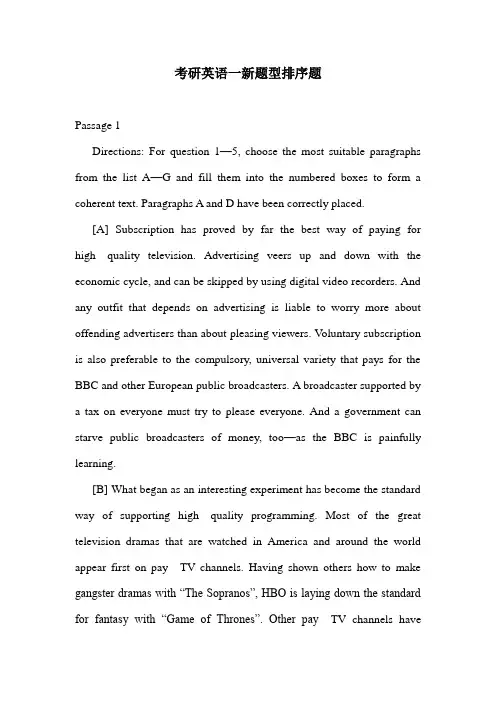
考研英语一新题型排序题Passage 1Directions: For question 1—5, choose the most suitable paragraphs from the list A—G and fill them into the numbered boxes to form a coherent text. Paragraphs A and D have been correctly placed.[A] Subscription has proved by far the best way of paying for high quality television. Advertising veers up and down with the economic cycle, and can be skipped by using digital video recorders. And any outfit that depends on advertising is liable to worry more about offending advertisers than about pleasing viewers. V oluntary subscription is also preferable to the compulsory, universal variety that pays for the BBC and other European public broadcasters. A broadcaster supported by a tax on everyone must try to please everyone. And a government can starve public broadcasters of money, too—as the BBC is painfully learning.[B] What began as an interesting experiment has become the standard way of supporting high quality programming. Most of the great television dramas that are watched in America and around the world appear first on pay TV channels. Having shown others how to make gangster dramas with “The Sopranos”, HBO is laying down the standard for fantasy with “Game of Thrones”. Other pay TV channels havedelved into 1960s advertis ing (“Mad Men”), drug dealing (“Breaking Bad”) and Renaissance court society (“The Borgias”). Pay TV firms outside America, like Britain s BSkyB, are beginning to pour money into original series. Talent is drifting to pay television, in part because there are fewer appealing roles in film. Meanwhile, broadcast networks have retreated into a safe zone of sitcoms, police procedurals and singing competitions.[C] But pay television is now under threat, especially in America. Prices have been driven so high at a time of economic malaise that many people simply cannot afford it. Disruptive, deep pocketed firms like Amazon and Netflix lurk, whispering promises of internet delivered films and television shows for little or no money. Whether the lure of such alternatives or poverty is what is causing people to cancel their subscriptions is not clear. But the proportion of Americans who pay for TV is falling. Other countries may follow.[D] Pay TV executives argue that people will always find ways of paying for their wares, perhaps by cutting back on cinema tickets or bottled water. That notion seems increasingly hopeful. Every month it appears more likely that the pay TV system will break down. The era of ever growing channel choice is coming to an end; cable and satellite distributors will begin to prune the least popular ones. They may push “best of basic” packages, offering the most desirable channels—andperhaps leaving out sport. In the most disruptive scenario, no longer unimaginable, pay TV would become a free for all, with channels hawking themselves directly to consumers, perhaps sending their content over the internet. How can media firms survive in such a world?[E] Fifteen years ago nearly all the television shows that excited critics and won awards appeared on free broadcast channels. Pay television (or, as many Americans call it, “cable”) was the domain of repeats, music videos and televangelists. Then HBO, a subscription outfit mostly known for boxing and films, decided to try its hand at hour long dramas.[F] But television as a whole should emerge stronger. If people buy individual channels rather than a huge bundle, they will have to think about what they really value—the more so because each channel will cost more than it does at present. Media firms will improve their game in response. The activity that diverts the average American for some four and a half hours each day should become more gripping, not less.[G] It won t be easy. They will have to start marketing heavily: at present the pay TV distributors do that for them. They must produce much more of their own programming. Repeats and old films lose their appeal in a world in which consumers can instantly call up vast archives. If they are to sell directly to the audience they will have to become technology firms, building apps and much slicker websites than they havenow, which anticipate what customers might want to watch.1→2→A→3→D→4→5Passage 2Directions: For question 1—5, choose the most suitable paragraphs from the list A—G and fill them into the numbered boxes to form a coherent text. Paragraphs D and E have been correctly placed.[A] For publishers, though, it is a dangerous time. Book publishing resembles the newspaper business in the late 1990s, or music in the early 2000s. Although revenues are fairly stable, and the traditional route is still the only way to launch a blockbuster, the climate is changing. Some of the publishers functions—packaging books and promoting them to shops—are becoming obsolete. Algorithms and online recommendations threaten to replace them as arbiters of quality. The tide of self published books threatens to swamp their products. As bookshops close, they lose a crucial showcase. And they face, as the record companies did, a near monopoly controlling digital distribution: Amazon’s grip over the ebook market is much like Apple’s control of music downloads.[B] They also need to become more efficient. Digital books can be distributed globally, but publishers persist in dividing the world into territories with separate editorial staffs. In the digital age it is daft to take months or even years to get a book to market. And if they are to distinguish their wares from self published dross, they must get better atchoosing books, honing ideas and polishing copy. If publishers are to hold readers’attention they must tell a better story—and edit out all the spelling mistakes as well.[C] For readers, this is splendid. Just as Amazon collapsed distance by bringing a huge range of books to out of the way places, it is now collapsing time, by enabling readers to download books instantly. Moreover, anybody can now publish a book, through Amazon and a number of other services.[D] During the next few weeks publishers will release a crush of books, pile them onto delivery lorries and fight to get them on the display tables at the front of bookshops in the run up to Christmas. It is an impressive display of competitive commercial activity. It is also increasingly pointless.[E] Yet there are still two important jobs for publishers. They act as the venture capitalists of the words business, advancing money to authors of worthwhile books that might not be written otherwise. And they are editors, picking good books and improving them. So it would be good, not just for their shareholders but also for intellectual life, if they survived.[F] More quickly than almost anyone predicted, e books are emerging as a serious alternative to the paper kind. Amazon, comfortably the biggest e book retailer, has lowered the price of its Kindlee readers to the point where people do not fear to take them to the beach. In America, the most advanced market, about one fifth of the largest publishers sales are of e books. Newly released blockbusters may sell as many digital copies as paper ones. The proportion is growing quickly, not least because many bookshops are closing.[G] They are doing some things right. Having watched the record companies impotence after Apple wrested control of music pricing from them, the publishers have managed to retain their ability to set prices. But they are missing some tricks. The music and film industries have started to bundle electronic with physical versions of their products—by, for instance, providing those who buy a DVD of a movie with a code to download it from the internet. Publishers, similarly, should bundle e books with paper books.D→1→2→3→E→4→5Passage 3Directions: For question 1—5, choose the most suitable paragraphs from the list A—G and fill them into the numbered boxes to form a coherent text. Paragraphs C and F have been correctly placed.[A] Fifteen years ago Vincent Bolloré, a French industrialist, decided to get into the business of electricity storage. He started a project to produce rechargeable batteries in two small rooms of his family mansion in Brittany. “I asked him, ‘what are you doing? and I told him to stop,that it wouldn t go anywhere,” says Alain Minc, a business consultant in Paris who has advised Mr Bolloré for many years. Fortunately, he says, Mr Bolloré continued.[B] The real aim for Mr Bolloré, however, is to showcase his battery technology. His group has developed a type of rechargeable cell, called a lithium metal polymer (LMP) battery. This is different from the lithium ion batteries used by most of the car industry. Mr Bollorébelieves fervently that his batteries are superior, mainly because they are safer. Lithium ion batteries can explode if they overheat—which in the past happened in some laptops. Carmakers incorporate safety features to prevent the batterys cells from overheating.[C] The city of Paris will cover most of the cost of the stations, but Mr Bolloré will pay an estimated 105m to supply his design of “Bluecar” vehicles and their batteries. He will bear a further 80m a year in running costs. The city s estimates for how popular the new service will be are highly optimistic, said a recent study by the government. Autolib could make 33ma year for Mr Bolloré, according to the study, but it could easily just breakeven or lose as much as 60mannually. Autolib will also be the first time the group has operated in a big consumer facing business where it will be held directly responsible for problems such as vandalism or breakdowns.[D] Going up against the rest of the car industry may seem quixotic.Before he won Autolib, Mr Bolloré says, people may well have thought he and his team were mad to venture into such a new area. But they underestimated his group s knowledge of electricity storage, he maintains. And if the growing number of electric cars on the road does lead to safety concerns over batteries, then Mr Bollorés LMP technology could move from the margin to the mainstream—provided, of course, they pass their test on the streets of Paris.[E] “Being a family company means we can invest for the long term,” says Mr Bolloré, who has spent 1.5 billion on battery development since 1996. Most of his group s money comes from transport and logistics, with a strong position in Africa, and from petrol distribution in France. Mr Bolloré has also made billions from financial investments such as in Rue Imperiale, a holding company. Autolib will be keenly watched throughout the car industry. It is the first large scale city car sharing service to use only electric vehicles from the outset; a scheme in Ulm in Germany, by contrast, started with diesel vehicles. Running Autolib could mean shouldering substantial losses for the BolloréGroup. Mr Bolloréwas not expected to win the contract, but did so mainly because he offered low rental charges for drivers.[F] Mr Bollorés LMP batteries are said to be more stable when being charged and discharged, which is when batteries come under most strain. Just two European carmakers have seen the batteries, which aremade only by the Bolloré Group. One car industry executive says that though the LMP technology is attractive from a safety point of view, the batteries have to be heated up to function—which takes power and makes them less convenient to use.[G] Mr Bollorés technology is about to hit the road. In his group won a contract to run Autolib, a car sharing scheme designed by Bertrand Delan e, the mayor of Paris, which will put 3,000 electric vehicles on the city s streets along with 1,120 stations for parking and recharging. Construction of the stations started in the summer, and Mr Bolloré will begin testing the service on October 1st before opening it to the public in December. Rechargeable batteries are now an important technology for the global car industry as it starts to make ever more electric and hybrid vehicles. Renault, a French manufacturer, is alone investing 4 billion ($5.6 billion) in a range of electric models which it will start selling this autumn. Many producers will unveil new electric vehicles next week when the Frankfurt Motor Show opens.1→2→3→C→4→F→5Passage 4Directions: For question 1—5, choose the most suitable paragraphs from the list A—G and fill them into the numbered boxes to form a coherent text. Paragraphs A and D have been correctly placed.[A] The contest has been held in anticipation of a new era of pylonbuilding. By XX, a quarter of the country s current generating capacity will need replacing; the government hopes the new supply will come from renewable sources such as onshore and offshore wind farms. Today s offshore capacity is just 7% of ministers targets for the end of the decade—and all of the new generation out to sea will need to land transmission cables ashore. The existing electricity grid is in the wrong place for many of these new sources of power. That creates a paradox: trying to save the world by cutting carbon emissions means scarring particular bits of it by dragging new power lines through scenic countryside.[B] This is an old problem. The launch of Britain s national electricity grid in 1933 was decried for desecrating the landscape. More recently, the location of wind farms has prompted similar debates. The difficulty with pylons is that they go everywhere. Scotland has had nearly five years of disputes over the planned 600pylon upgrade of a transmission line running from Beauly in the Highlands to the central belt where more electricity is used. The same clashes will now play out in England and Wales. A new planning commission was set up in 2009 to speed up the glacial pace of infrastructure decision making. But weighing economic demands against beauty remains a thorny and potentially time-consuming job.[C] Opponents of towering pylons say the answer is to bury powerlines: at present only 950km of Britain s 13,000km of high voltage cable runs underground, most of it in urban areas. But sinking wires, which means clearing a corridor 17m to 40m wide and cannot be done in all terrains, ca rries an environmental toll too. “You are effectively sterilising land use in the area,” says Richard Smith of National Grid; no planting, digging or building is allowed. That makes installing subsurface cables 12 to 17 times as pricey as overhead lines, according to National Grid (they also need replacing sooner). Since consumers pay for this through their electricity bills, everyone would have to fork out to protect the views and house prices of a few people.[D] So finding a new shape for pylons may be only one aspect of the coming power rows. But it will be a tricky one. Typically the best designs combine elegance with utility. Yet rather than being a feature in itself, the optimal pylon blends in with nature. That s a tough task for 20 tons of steel, however impressively shaped.[E] The skeletal, lattice design of Britain s electricity pylons has changed little since the first one was raised in 1928. Many countries have copied these “striding steel sentries”, as the poet Stephen Spender called them; more than 88,000 now march across the country s intermittently green and pleasant land.[F] Now six new models are vying to replace these familiar steel towers. The finalists in a government sponsored competition to design anew pylon include a single shard spiking into the sky and an arced, open bow. After a winner is picked in October, National Grid, which runs the electricity transmission network, will decide whether to construct it.[G] But the price of despoiling pretty scenery is hard to calculate. The risk is that the cost of damaging the landscape is ignored because it is not ascribed a monetary value, says Steve Albon, co author of a government commissioned report on how much the natural environment contributes to Britain s economy. As yet, though, no one has found an easy or accepted measure of this worth to help make decisions.1→2→A→3→4→5→DPassage 5Directions: For question 1—5, choose the most suitable paragraphs from the list A—G and fill them into the numbered boxes to form a coherent text. Paragraphs C and E have been correctly placed.[A] Nor can it buy companies as freely as postal services in Europe, Canada or Asia have been doing for the past decade. Many European countries, as well as New Zealand and Japan, have already privatised or liberalised their postal services. Combined, foreign posts now get most of their revenue from new businesses such as retailing or banking for consumers, or warehousing and logistics for companies.[B] THE US Postal Service has an unofficial creed that harks back toHerodotus, who was admiring the Persian Empire s stalwart messengers. Its own history is impressive too, dating to a royal license by William and Mary in 1692, and including Benjamin Franklin as a notable postmaster, both for the crownand then for the newly independent country. Ever since, the post has existed “to bind the Nation together”.[C] Quasi independent since 1970, the post gets no public money. And yet it is obliged (as FedEx and UPS are not) to visit every mailbox, no matter how remote, six days a week. This has driven the average cost of each piece of mail up from 34 cents in 2006 to 41 cents. Yet the post is not allowed to raise prices (of stamps and such) willy nilly; a 2006 law set formulas for that. So in effect, the post cannot control either its costs or its revenues.[D] So America s post is looking for other solutions. It is planning to close post offices; up to 3,653, out of about 32,000. This month it announced plans to lay off another 120,000 workers by , having already bidden adieu to some 110,000 over the past four years (for a total of about 560,000 now). It also wants to fiddle with its workers pensions and health care.[E] Ultimately, says Mr Donahoe, the post will have to stop delivering mail on Saturdays. Then perhaps on other days too. The post has survived new technologies before, he points out. “In 1910, we owned the most horses, by 1920 we owned the most vehicles.” But the internet just mightsend it the way of the pony express.[F] But as ever more Americans go online instead of sending paper, the volume of mail has been plummeting. The decline is steeper than even pessimists expected a decade ago, says Patrick Donahoe, the current postmaster general. Worse, because the post must deliver to every address in the country—about 150m, with some 1.4m additions every year—costs are simultaneously going up. As a result, the post has lost $20 billion in the last four years and expects to lose another $8 billion this fiscal year.[G] And although the recession made everything worse, the internet is the main culprit. As Christmas cards have gone online (and “green”), so have bills. In 2000, 5% of Americans paid utilities online. Last year 55% did, and eventually everybody will, says Mr Donahoe. Photos now go on Facebook, magazines come on iPads. Already, at least for Americans under a certain age, the post delivers only bad news or nuisances, from jury summonses to junk mail. Pleasant deliveries probably arrive by a parcel service such as UPS or FedEx.1→2→3→C→4→5→E。
2021考研英语(一)新题型之排序题冲刺复习建议
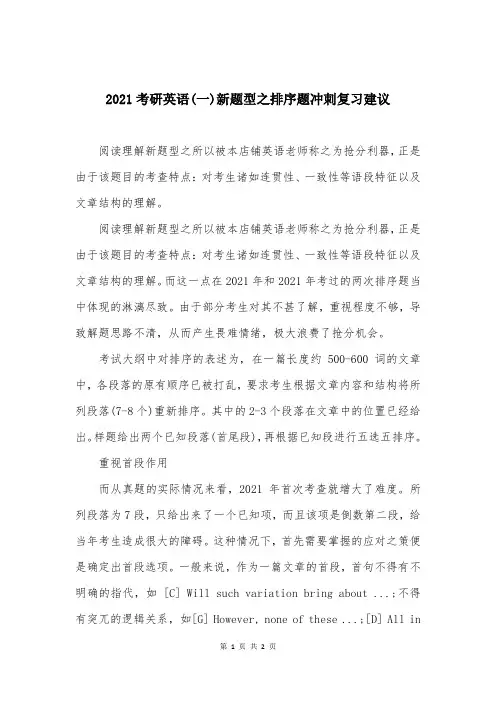
2021考研英语(一)新题型之排序题冲刺复习建议阅读理解新题型之所以被本店铺英语老师称之为抢分利器,正是由于该题目的考查特点:对考生诸如连贯性、一致性等语段特征以及文章结构的理解。
阅读理解新题型之所以被本店铺英语老师称之为抢分利器,正是由于该题目的考查特点:对考生诸如连贯性、一致性等语段特征以及文章结构的理解。
而这一点在2021年和2021年考过的两次排序题当中体现的淋漓尽致。
由于部分考生对其不甚了解,重视程度不够,导致解题思路不清,从而产生畏难情绪,极大浪费了抢分机会。
考试大纲中对排序的表述为,在一篇长度约500-600词的文章中,各段落的原有顺序已被打乱,要求考生根据文章内容和结构将所列段落(7-8个)重新排序。
其中的2-3个段落在文章中的位置已经给出。
样题给出两个已知段落(首尾段),再根据已知段进行五选五排序。
重视首段作用而从真题的实际情况来看,2021年首次考查就增大了难度。
所列段落为7段,只给出来了一个已知项,而且该项是倒数第二段,给当年考生造成很大的障碍。
这种情况下,首先需要掌握的应对之策便是确定出首段选项。
一般来说,作为一篇文章的首段,首句不得有不明确的指代,如 [C] Will such variation bring about ...;不得有突兀的逻辑关系,如[G] However, none of these ...;[D] All inall, ...;更不可能直接以举例开篇,如[F] For example, ...,而是应当提出问题,或通过描述现象来引出问题,故而[A] The first and more important ...也不适合作为开篇首段。
[E]的位置已固定,由此可确认 [B] 为本文开篇段落的不二之选。
从已知到未知首段的内容确定了全文的主题,一个常规的思路便是从前往后按顺序解题,当遇到瓶颈时,可以暂时搁置,转向另一已知段落的位置,根据该段首尾句逻辑关系解题。
考研英语新题型排序题技巧
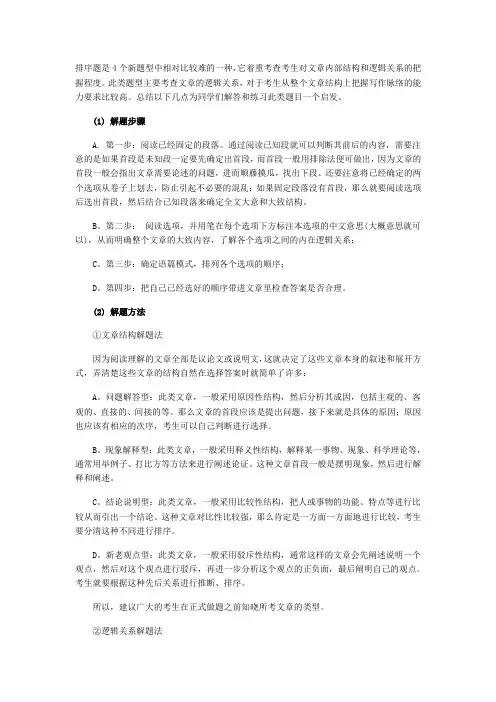
排序题是4个新题型中相对比较难的一种,它着重考查考生对文章内部结构和逻辑关系的把握程度。
此类题型主要考查文章的逻辑关系,对于考生从整个文章结构上把握写作脉络的能力要求比较高。
总结以下几点为同学们解答和练习此类题目一个启发。
(1) 解题步骤A. 第一步:阅读已经固定的段落。
通过阅读已知段就可以判断其前后的内容,需要注意的是如果首段是未知段一定要先确定出首段,而首段一般用排除法便可做出,因为文章的首段一般会指出文章需要论述的问题,进而顺藤摸瓜,找出下段。
还要注意将已经确定的两个选项从卷子上划去,防止引起不必要的混乱;如果固定段落没有首段,那么就要阅读选项后选出首段,然后结合已知段落来确定全文大意和大致结构。
B。
第二步:阅读选项,并用笔在每个选项下方标注本选项的中文意思(大概意思就可以),从而明确整个文章的大致内容,了解各个选项之间的内在逻辑关系;C。
第三步:确定语篇模式,排列各个选项的顺序;D。
第四步:把自己已经选好的顺序带进文章里检查答案是否合理。
(2) 解题方法①文章结构解题法因为阅读理解的文章全部是议论文或说明文,这就决定了这些文章本身的叙述和展开方式,弄清楚这些文章的结构自然在选择答案时就简单了许多:A。
问题解答型:此类文章,一般采用原因性结构,然后分析其成因,包括主观的、客观的、直接的、间接的等。
那么文章的首段应该是提出问题,接下来就是具体的原因;原因也应该有相应的次序,考生可以自己判断进行选择。
B。
现象解释型:此类文章,一般采用释义性结构,解释某一事物、现象、科学理论等,通常用举例子、打比方等方法来进行阐述论证。
这种文章首段一般是摆明现象,然后进行解释和阐述。
C。
结论说明型:此类文章,一般采用比较性结构,把人或事物的功能、特点等进行比较从而引出一个结论。
这种文章对比性比较强,那么肯定是一方面一方面地进行比较,考生要分清这种不同进行排序。
D。
新老观点型:此类文章,一般采用驳斥性结构,通常这样的文章会先阐述说明一个观点,然后对这个观点进行驳斥,再进一步分析这个观点的正负面,最后阐明自己的观点。
2021年考研英语一阅读新题型真题解析
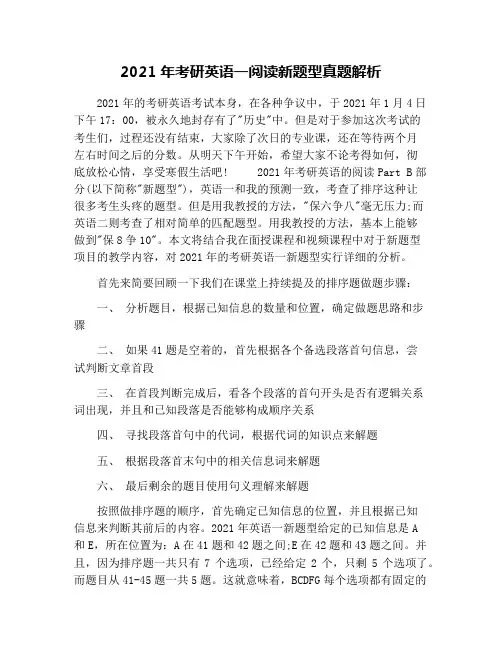
2021年考研英语一阅读新题型真题解析2021年的考研英语考试本身,在各种争议中,于2021年1月4日下午17:00,被永久地封存有了"历史"中。
但是对于参加这次考试的考生们,过程还没有结束,大家除了次日的专业课,还在等待两个月左右时间之后的分数。
从明天下午开始,希望大家不论考得如何,彻底放松心情,享受寒假生活吧! 2021年考研英语的阅读Part B部分(以下简称"新题型"),英语一和我的预测一致,考查了排序这种让很多考生头疼的题型。
但是用我教授的方法,"保六争八"毫无压力;而英语二则考查了相对简单的匹配题型。
用我教授的方法,基本上能够做到"保8争10"。
本文将结合我在面授课程和视频课程中对于新题型项目的教学内容,对2021年的考研英语一新题型实行详细的分析。
首先来简要回顾一下我们在课堂上持续提及的排序题做题步骤:一、分析题目,根据已知信息的数量和位置,确定做题思路和步骤二、如果41题是空着的,首先根据各个备选段落首句信息,尝试判断文章首段三、在首段判断完成后,看各个段落的首句开头是否有逻辑关系词出现,并且和已知段落是否能够构成顺序关系四、寻找段落首句中的代词,根据代词的知识点来解题五、根据段落首末句中的相关信息词来解题六、最后剩余的题目使用句义理解来解题按照做排序题的顺序,首先确定已知信息的位置,并且根据已知信息来判断其前后的内容。
2021年英语一新题型给定的已知信息是A和E,所在位置为:A在41题和42题之间;E在42题和43题之间。
并且,因为排序题一共只有7个选项,已经给定2个,只剩5个选项了。
而题目从41-45题一共5题。
这就意味着,BCDFG每个选项都有固定的位置,只要你摆错一个选项的位置,就一定会产生连环性的错误。
而反过来说,在不算作弊的情况下,5道题目全部选择一个选项,必然会对一个。
这些推理都是我在课堂上面给大家说过的。
2021考研英语新题型-三种常考题的命题方向及考点
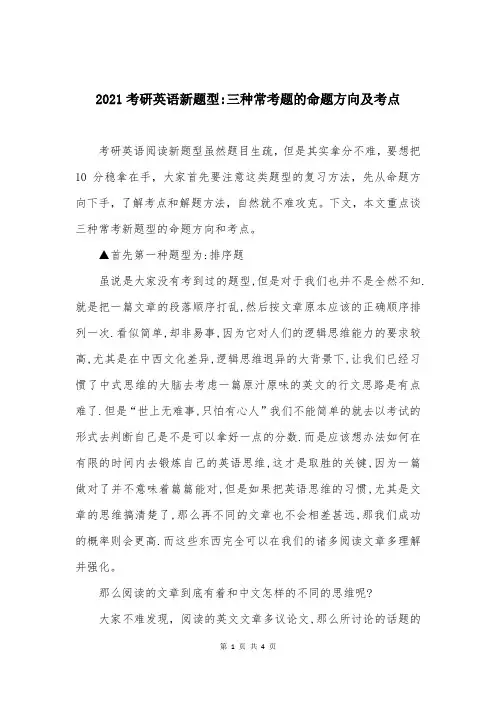
2021考研英语新题型:三种常考题的命题方向及考点考研英语阅读新题型虽然题目生疏,但是其实拿分不难,要想把10分稳拿在手,大家首先要注意这类题型的复习方法,先从命题方向下手,了解考点和解题方法,自然就不难攻克。
下文,本文重点谈三种常考新题型的命题方向和考点。
▲首先第一种题型为:排序题虽说是大家没有考到过的题型,但是对于我们也并不是全然不知.就是把一篇文章的段落顺序打乱,然后按文章原本应该的正确顺序排列一次.看似简单,却非易事,因为它对人们的逻辑思维能力的要求较高,尤其是在中西文化差异,逻辑思维迥异的大背景下,让我们已经习惯了中式思维的大脑去考虑一篇原汁原味的英文的行文思路是有点难了.但是“世上无难事,只怕有心人”我们不能简单的就去以考试的形式去判断自己是不是可以拿好一点的分数.而是应该想办法如何在有限的时间内去锻炼自己的英语思维,这才是取胜的关键,因为一篇做对了并不意味着篇篇能对,但是如果把英语思维的习惯,尤其是文章的思维搞清楚了,那么再不同的文章也不会相差甚远,那我们成功的概率则会更高.而这些东西完全可以在我们的诸多阅读文章多理解并强化。
那么阅读的文章到底有着和中文怎样的不同的思维呢?大家不难发现,阅读的英文文章多议论文,那么所讨论的话题的开篇方式有两种主要的类型:一种是开篇点题型文章的开头直接阐述作者的某一观点,或对某一事件,或对某一问题的看法.然后在下文中以各种论证手法去论证.这属于比较简单的一类文章,比较好辨别.另一种是开篇引入型虽说文章的主要形式还是论点-论据的写法,但是与开篇点题型文章不同的一点那就是:他们会在文章的开头引入一段看似与主要内容不太相关,有时甚至是相反的内容,目的只有一个,就是为了引出文章的中心论点.这样的内容多以1-2个篇幅相对较短的自然段落所构成.而这样的类型的文章会被误以为有两个中心主题,那么碰到类似文章的时候一定要判断哪个才是真正的主题,并且两者之间有一定过渡,比如转折,比如承接,如常见的:but,yet,however,表示转折,这种转折体现在文章中有三种方式:一:在首段提出作为引子的命题后,马上就转折;二:开头提出其他命题,在首段结尾处开始转折;三:开头提出命题,在下一段的句首开始转折;除了文章的开头篇有别以外在英语的文章中,经常会有支撑论点性的细节出现,这些细节性的因素主要作用就是用来充实和证明论点,并且一般会调理清晰,所以在段落之间的逻辑性也是相当强有时也会穿插一些例子等.了解了英语文章的一些主要写作方式和逻辑思维后,我们就要去阅读一定量的文章,并且能够在阅读后,着重去捉住这些文章的篇章结构去分析和辨别,相信对于做新题型的排序题有很大的帮助.▲其次是七选五如果说排序题是考察文章的整体框架结构的话,那七选五题型考察的就是对于文中逻辑的判断能力,考察的是段落中的内部逻辑关系,要求更加的缜密,但是因为有了上下文的参照,所以相对比较简单.对于七选五的题型,对于大家的要求则是要关注英语阅读文章中的惯用的衔接和连接手段,比如人称代词的用法,连接词的逻辑关系,和一切重复出现的关键词语,均是做七选五的关键.当然有一些干扰项的排除其实也需要引起足够的重视,这时对大家的要求就是一定要谨记本文的中心大意,只有不偏离中心,才可以不受干扰项的影响,提高做题效率.那么,对于这一类型的题目我们更加注重文章中的上下文衔接,平日在做阅读时养成好的习惯,常思考,勤分析,不要把文章只理解成孤立的句子存在,那么这类为题就迎刃而解了。
2021年考研英语新题型
2021年考研英语新题型【原创实用版】目录1.2021 年考研英语新题型概述2.新题型的三种类型3.新题型答题分析4.新题型解题方法5.新题型复习指导正文2021 年考研英语新题型概述随着 2021 年考研英语备考的进行,很多考生开始关注新题型的备考策略。
新题型主要分为三种类型:7 选 5、5 选 5 排序题和翻译题。
在这篇文章中,我们将详细介绍这三种类型,并提供相应的答题分析、解题方法和复习指导,帮助考生更好地应对新题型。
新题型的三种类型1.7 选 5 题型:这种题型要求考生根据一篇 500 词左右的文章,从给出的 6-7 段文字中选择能分别放进文章中 5 个空白处的 5 段。
这种题型主要考查考生的阅读理解能力和逻辑推理能力。
2.5 选 5 排序题:这种题型是将一篇 500 词左右的文章原有顺序打乱,要求考生根据文章内容把 5 个段落重新排序。
这种题型主要考查考生的快速阅读能力和把握文章结构的能力。
3.翻译题:这种题型要求考生根据给出的中文或英文,翻译成相应的英文或中文。
这种题型主要考查考生的语言表达能力和翻译能力。
新题型答题分析对于新题型,考生需要弄清考查目的。
新题型其实是阅读的一种补充,快速阅读文章的特点往往是篇幅长、生词多,但由于考题本身相对简单,答题速度就要求很快。
因此,在答题过程中,考生需要快速捕捉关键词句,把握文章的逻辑关系和结构。
新题型解题方法1.阅读给定段落,理解段落内容,了解文章围绕何话题、何对象展开。
2.留意关键词句,如:段落中间若有转折词,要关注转折词及其所在句子;无转折词则应看段首句、第二句及段尾句;重点关注名词、代词等。
3.分析文章的逻辑关系和结构,根据题意选择合适的答案。
新题型复习指导1.熟悉题型:考生需要对新题型的种类和特点有所了解,以便在考试中迅速识别和应对。
2.练习答题技巧:通过模拟题和真题的练习,不断提高快速阅读、捕捉关键信息和分析逻辑关系的能力。
3.提高阅读水平:阅读是新题型的基础,考生需要通过大量的阅读来提高自己的阅读速度和理解能力。
2021年考研英语一大纲:新题型备考多注意7选5
2021年考研英语一大纲:新题型备考多注意7选5备选题型有:1)在一篇总长度为500-600词的文章中有5段空白,文章后有6-7段文字。
要求考生根据文章内容从这6-7段文字中选择能分别放进文章中5个空白处的5段。
2)在一篇长度为500-600词的文章中,各段落的原有顺序已被打乱。
要求考生根据文章的内容和结构将所列段落(7-8个)重新排序,其中有2-3个段落在文章中的位置已给出。
3)在一篇长度约500词的文章前或后有6-7段文字或6-7个概括句或小标题。
,这些文字或标题分别是对文章中某一部分的概括。
阐述或举例。
要求考生根据文章内容,从这6-7个选项中选出最恰当的5段文字或5个标题填入文章的空白处。
这三种形式也就是我们常说的7选5,排序和匹配题(标题匹配和信息匹配题)。
当前自从2005年有新题型开始这10年的考查分布如下:1)2005、2006、2008、2009、2021和2021年都考查是7选5.2)2021、2021和2021年考查的都是排序题。
3)2007年考查的标题匹配。
4)当前没有考查过信息匹配题。
此题型是根据标题和下文的阐述,找出相对应的例子,也就是说考查的是论点和论据的水平。
在7选5中,2009年的题是最难,出现过得分率只有0.14和0.11的题目。
希望广大考生在复习新题型的时候多注意7选5.排序题是变形的7选5.那跨考教育肖方方老师对备考给出以下建议:1)多注意代词。
选项和空空前后的代词是送分题。
注意this 加名词,these加名词.以及such加名词和定冠词加名词,往往是得分点。
比如2021的42,是根据E选项的“this separation, ”选出答案D,41题是根据D选项第一句的such courses 选出B ,因为只有B中有humanities(人文学科)与其对应。
2021年的43,44;2021年的43题中的these keywords等等。
这是送分题。
2)多注意上下文内容是否一致。
考研英语(一)第三部分新题型:排序、总结、句子匹配
考研英语(一)第三部分新题型:排序、总结、句子匹配(江南博哥)第一节排序材料题根据下面资料,回答1-5题A.Is there still a place for the tiddlers? "That's an explicit yes," says Bob Shea of NACUBO, "do there need to be mergers and acquisitions? That's an unequivocal yes as well." Many small colleges serve niche markets, including a large faith-based one. "Many students wouldn't go to college at all or would be lost in a large one," says Ms. Brown.B.Part of the problem, at least for small liberal arts institutions, is that parents and would-be students are questioning the value of the liberal arts. They want a solid return, in the form of a well-paying job, for their four-year investment. There are still an awful lot of small places:about 40% of degree-granting colleges have fewer than 1,000 students. But enrolment at these institutions has fallen by more than 5% since 2010, while the student population has increased overall.C.Some tiny colleges rely on donations to save the day. Alumni are concerned about the value of their own degree if the college closes, but donors can grow weary. Marlboro, meanwhile, is using its endowment to offer scholarships to one student from each state in an effort to expand its usual pool from New England and to open up new student pipelines. It saw success straight away. It increased its student population by 6% this academic year, after years of falling enrolment.D.Visitors stand out at Marlboro College's pastoral campus in the woods of Vermont, but not because they are special or even unexpected. With 190 enrolled students and just a few dozen faculty and staff, everyone knows everyone. The student-faculty ratio is five to one, about the lowest in the country. The college administration has worked hard to stay small:the student population has rarely topped 350. But in the years since its founding after the Second World War, Marlboro has often skirted financial ruin. In 1993 it had only a few payrolls left in the bank. It was rescued by a foundation. Today it is looking for ways to save itself and already seeing some success.E.To attract students, some colleges are reducing their sticker price, but this is not sustainable for colleges without healthy endowments. According to the National Association of College and University Business Officers (NACUBO), 49% of independent colleges and universities give discounts, up from 38% a decade ago. F.Alice Brown, a former head of the Appalachian College Association, a network of tiny colleges in the Appalachian Mountains, thinks more must merge or close. The Berkeley College of Music (4,371 students) and the Boston Conservatory (730 students) merged in June. Small colleges often share accountants or laboratories already.G.Marlboro is not alone in facing revenue and enrolment pressures. Burlington College(70 students), also in Vermont, shut its doors over the summer. Sweet Briar, a well-regarded women's college in Virginia, nearly closed to its 245 students last year.A last minute bout of fundraising by alumni saved it, for now. Moody's, acredit-ratings agency, said in 2015 that the pace of closures and mergers willaccelerate and could triple from an average of five per year over the next few years. Dennis Gephardt of Moody's says closures and mergers will be concentrated among the smallest colleges.1 [单选题]第(41)题选_______A.AB.BC.CD.DE.EF.FG.G正确答案:G参考解析:第一段谈到了,万宝路学院的基本情况,重点介绍了万宝路学院一直努力保持学院规模小型化:学生人数很少超过350人。
2021年1月考研英语真题答案分析之新题型
2021年1月考研英语真题答案分析之新题型2021年英语考研新题型部分难度较以前难度增加了很多。
以下附上的是新题型原文以及考研新题型真题,大家可以做以比较,希望对大家的学习有所帮助。
2021年英语考研新题型部分难度较以前难度增加了很多。
首先,新题型以排序形式出现还是第一次,而且在题型上和大纲里的排序题也有所差别。
按照以往的经验,大纲里排序题一般会给出五个段落,把次序打乱再进行排序即可,而今年的排序要求学生从六个选项中排除一个干扰项再把其余的选项进行排序,这样来说,今年的新题型有一定的新颖性在里面;其次,大纲中的排序题给出两个已知段落,一般是首尾段,再根据已知的段落进行五选五排序,而今年的排序题只给出来了一个已知选项,而且这个已知选项是倒数第二段,这样给考生解题就带来了很大的难度。
另外,从题目的取材方面来说,这篇文章是一篇经济类的文章,摘自2003年第一期《麦肯锡周刊》(The Mckinsey Quartly)本文下方附有原文的链接,可供考生参考,11界的考生也需要关注国外类似的杂志。
这本杂志已经是第二次被考研英语命题专家选为命题的素材库了。
整个文章主要描述目前欧洲的消费品零售商在欧洲面临的发展停滞的问题,但他们却忽视了在他们身边一个潜在的市场以及消费者习惯发生改变的事实。
最后通过和原文对比就会发现,考研命题专家在出题的时侯把原文的段落进行了组合和删减速。
原文中一段在考题中变成了两段,而原文中的末尾在考题中又和下一段接在了一起,形成了一个新的段落,这样给考生解题带来了非常大的困难。
以下附上的是新题型原文以及考研新题型真题,大家可以做以比较,希望对大家的学习有所帮助。
A wholesale shift in European groceries1、BRetail sales of food and drink in Europe’s largest markets are at a standstill, leaving European grocery retailers hungry for opportunities to grow. Most leading retailers have already tried e-commerce, with limited success, and expansion abroad, often with more. But almost all have ignored the big, profitable opportunity in their own backyard: the wholesale food and drink trade, which appears to be just the kind of market retailers need。
- 1、下载文档前请自行甄别文档内容的完整性,平台不提供额外的编辑、内容补充、找答案等附加服务。
- 2、"仅部分预览"的文档,不可在线预览部分如存在完整性等问题,可反馈申请退款(可完整预览的文档不适用该条件!)。
- 3、如文档侵犯您的权益,请联系客服反馈,我们会尽快为您处理(人工客服工作时间:9:00-18:30)。
XX年考研英语将出新题型排序题
晨报讯 (记者罗德宏代小琳)昨天记者获悉,xx年英语、 ___研究生入学考试大纲 ___。
记者从 ___、海文学校等考研 ___学校了解到,xx年英语考试大纲增加了新题型,而 ___考试大纲不同题型的分值有所变化。
昨天,记者了解到,继今年考研英语初试取消听力后,明年英语考研将可能新增排序题或标题内容搭配题。
北京 ___学校考研专家分析,明年大纲中出现的“排序题”是将一篇有7到8段的文章所有段落顺序打乱,然后给出其中2到3段的正确位置,要求考生把剩下的段落按照顺序排列。
而标题内容搭配题则要求考生在有限的时间内将文章中给出的五个标题或五个段落与相应的段落或标题相匹配。
海文学校副校长张锐向记者解析了xx年 ___大纲的变化。
张锐说,原来 ___考研卷中选择题占45分,大题——包括辨析和分析题占55分。
xx年选择题占50分,大题占50分。
在大题中,原来一直存在的辨析题取消了。
目前,xx年研究生入学英语、 ___考试大纲已经上市,考生可以在书店买到。
排列段落题和标题内容搭配题进入备选,英语初试仍不考听力
本报讯(记者郭少峰)明年的硕士研究生入学考试英语科目的考试可能出现排列段落题或标题内容搭配题。
昨天,xx年硕士研究生入学考试英语部分的大纲公布。
xx年硕士研究生入学考试英语科目的初试仍不考查听力部分,对于单词和词组的考查范围基本不变,完型填空、翻译、阅读理解、写作无变化。
xx年的硕士研究生入学英语考试第一次在“partb”部分出现了“7选5”或“完型填句”的题型。
而xx年大纲中除了规定“7选5”的题型作为“partb”部分的备选题之外,还规定了排列段落题和标题内容搭配题作为备选题型。
所谓排列段落题就是将一篇有7-8段的文章的所有段落顺序打乱,然后给出其中2-3段的正确位置,要求考生把剩下的段落按照顺序来排列。
而标题内容搭配题则要求考生在有限的时间内将文章中给出的5个标题或5个段落与相应的段落或标题进行匹配。
北京 ___学校国内考试部主任周雷说,在xx年大纲样题中给出的备选项都是多于题目的。
也就是说标题与内容之间;或者说论点与论据之间并不是一一对应的关系,这无形中又增加了题目的难度。
周雷建议考生可适当调整自己的复习安排,把听力学习放在一个较次要的位置上。
周雷预计,xx年考研英语 ___将至少有90%与xx年保持一致。
模板,内容仅供参考。
